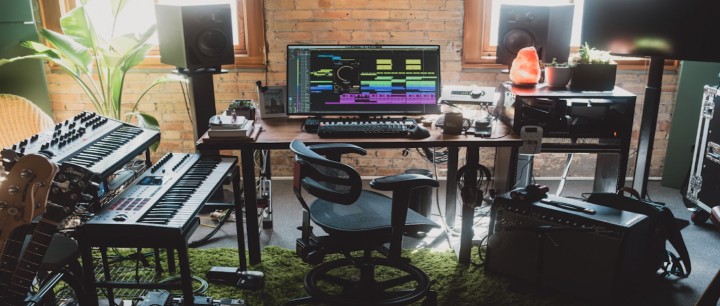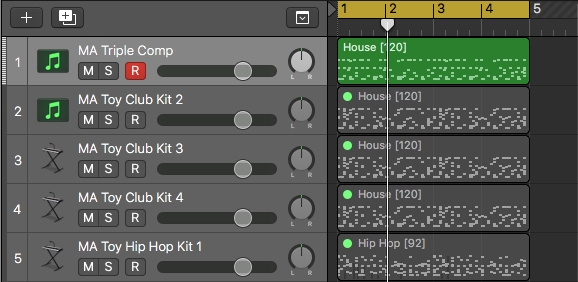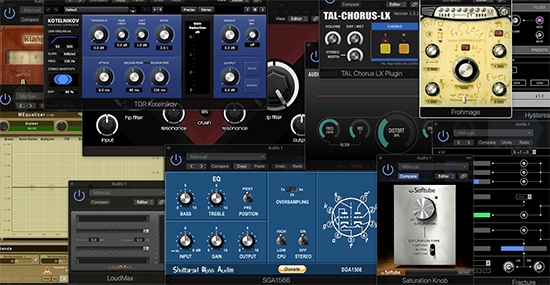
Today's guest post is written by Jennifer Webster of SoundMaximum, a music tech and gear blog.
The advance of music technology has made it possible for today's producers to wake up, turn on a laptop and start making music without even getting out of bed.
In the preceding decades, people who made their music at home were considered amateur or even non-professional - these days, it's far from uncommon for a billboard chart-topper to have been entirely created from within the confines of the artist's bedroom.
Whilst professional studios remain coveted spaces, no one really cares if your music was cooked up at home or in space - all that matters is the quality of the end result.
However, having your studio in your bedroom comes with a number of pitfalls that could prove damaging to your productivity. Distractions abound, and comfort and familiarity are often the antithesis of inspiration!
If you follow the right procedures and remain disciplined though, bedroom production can be every bit as rewarding as using a traditional recording space – with this in mind, here are my 7 steps to help you get the most out of your home studio:

1. Organise Your Time
If you make music from the comfort of your home, there’s a tendency to have a laid-back approach to it, since the studio isn’t going anywhere. You may be tempted to work on your music as time permit: 10 minutes here, 30 minutes there, squeeze in another 20 minutes in between and so on.
Stop - you’re hurting your creative process by doing things this way! If you work in an office during the day, you'll know that this way of working, full of procrastinating breaks and stoppages, is not tolerated precisely because it is a surefire method to lower productivity.
It’s best to mark out studio time on your timetable or schedule, just like you would if you were paying for studio time. It doesn’t have to be in long stretches - even an hour dedicated to music every day can lead to positive results.
As with any discipline, it's practice and repeated effort that leads to improvements and deeper understanding, so treat your production time like you're learning a new, physical musical instrument and stick at it.

2. Optimise Your Workspace
The area of your room that you use for music production should be well organised. Not being able to find something that you need quickly, or having to take time setting up instruments, mics, amps etc essential to your process is a total productivity killer!
Some people have a habit of just putting their laptop, soundcard and monitors on the bed, with the mic stand at the bedside. This will only work for you if you have another studio, and you just use your bedroom to create demos or simpler versions of your music.
Your workspace should contain all your gear, well-arranged such that you can easily lean in from your sitting position to turn any knobs or switches. Other gear that doesn't require frequent adjustments can be placed farther away.
On top of this, certain pieces of gear will perform differently depending on where they are, such as monitors. The typically recommended position is such that your ears form an equilateral triangle with your stereo pair, and keeping them in the same place means their position will never influence the phase relationships of your music.
You want to get to know the 'sound' of your speakers, for even the most expensive models impart some form of colouration on sounds they output. This will help you to create mixes that don't just sound good through your speakers but across many different systems - an essential part of the production process.

3. Work Out When You Feel Most Inspired
Whilst this may sound cliche, this is probably the area that gives producers the most problems. Should you make music in the day, or at night?
The most important factor to consider here is how your body works. While we can adapt to almost any conditions, some people function better in the day while others do better at night. This will probably also change as you age, so keep it flexible!
What you need to do is find out when you're most creative and double-down. Of course, you have to consider your daily schedule too but if you just don't feel creative during the day, make room in your calendar to produce at night.
Remember that distractions should be at an absolute minimum, so if you share your home with others who might be asleep or quieter in the evening, this is probably the time for you to head to the studio to work.
4. Manage Your Sample Collection
Whether you download your sample packs and loops online (such as from the ModeAudio collection) or record your own sounds, you should have a dedicated folder or drive just for them.
This way, when you download a new pack, you'll know exactly where to find your sounds - remember, wasting time on organisation duties is the absolute enemy of smooth workflow!
This is also important because, when you have numerous projects on your computer and you want to open a file from, say, 5 years ago, your DAW may have problems locating some of the samples used if they're scatted around your local and external HDs.
If your samples are well organised, you can easily determine whether or not you still have these sounds and move on from there.

5. Always Backup Your Files
It might be obvious again, but this right here is one of the most important things you can do for yourself and your career. It's a terrible feeling to realise that some of your work is gone forever, without any hope of getting it back!
My laptop fell from my desk recently and my hard drive was damaged as a result. I couldn't retrieve any of the files - a total nightmare!
I often think about old projects I lost that I will never be able to access again, some of them created years ago. Those old beats may not be my best, but they're still my beats and a part of my production journey - put simply, it hurts to lose stuff like that.
It's much less painful just to back up your files. Upload them to cloud storage, or copy projects to a dedicated backup HD and be safe in the knowledge that you can access them any time you want.

6. Organise Your DAW's Visual Arrangement
Some DAWs make it easier for you to arrange your workflow, while others don't. Either way, you should cultivate a habit of neat visual arrangement, so you have quick and easy access to the most important functions for your own specific process.
Structure your work such that a producer or mix engineer who isn't involved in the work can understand what's going on in less than a minute - this will mean that you'll always be able to revisit older sessions and continue working on them in an instant.
The process should start by naming your tracks. You can do this while recording or immediately after. Don't postpone it till when you want to mix the song - some songs can have so many parts that even though you made all the recordings and played all the instruments yourself, you may still end up confused and forgetful as to just what exactly that weird squiggly little waveform is doing!
Name your tracks accordingly as well as bus channels and sends - this way you won't have to waste any time soloing things just to find out what is running through that channel.

7. Make Room For Upgrades
As the saying goes, the largest room on earth is the room for improvement. Always check out new updates for your software and hardware, and stay in touch with new tech advances by visiting e-zines and blogs.
Innovations keep rolling out every day and you will do yourself a world of good by staying up-to-date. You don’t have to use every single new piece of kit out there, but being aware of what is coming out and what it can do at the very least, will help you to make choices about what next to invest in in order to advance and evolve your sound.
Conclusion
Whether you’re making music for commercial purposes, as a hobby or for charity, we all want to create entertaining, satisfying work for ourselves and for others to enjoy.
For bedroom producers, it can be tricky negotiating the boundary between your home life and music-making time but following some of the steps above will certainly see you taking several steps in the right direction!













